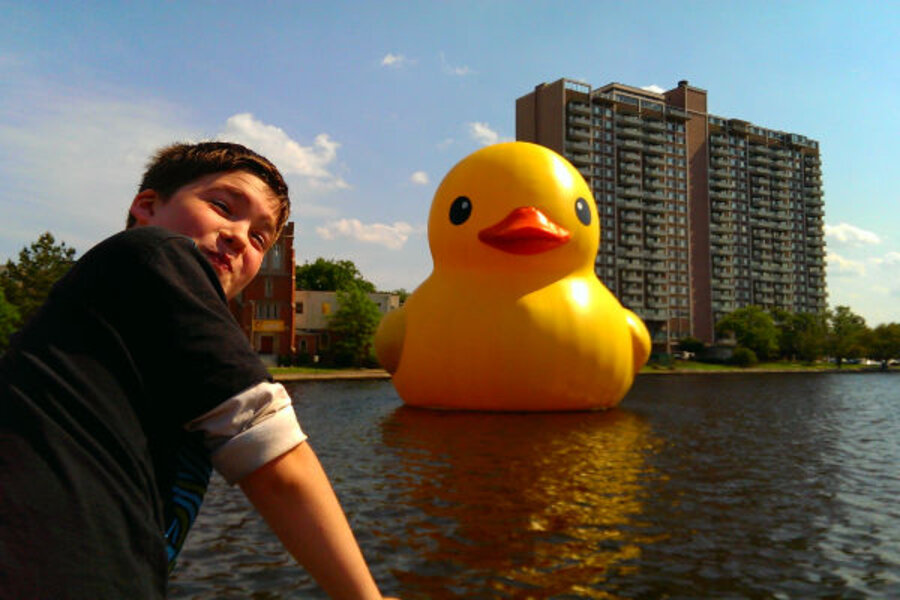Giant 'Rubber Duck' includes families as part of the art
Loading...
While the violent and destructive presence of Godzilla may be trying to dominate the movie box office, a placid, 40-foot rubber duck created by Artist Florentijn Hofman of the Netherlands is quietly winning over cities and parents desperate to get kids into the bath.
The duck has been floating around the world, from New York to Tokyo and will migrate to Los Angeles, Calif. this week.
As I write this story, the duck has finished his bath time here in an inlet called The Hague adjacent to The Chrysler Museum of Art in Norfolk, Va.. It was on display from May 17 through May 26, as an attraction to draw people to the museum’s re-opening after a massive remodel.
Thousands of people flocked to the what could be Godzilla’s bath toy day and night.
Perhaps that’s because this is the kind of Duck Dynasty anyone can feel politically correct about supporting. To be perfectly honest, my personal taste in art has always run more toward Degas than de duck.
However, I am forced to admit that what happens around this big bird is a form of family performance art I can really appreciate. My husband, a newspaper designer, was quick to use the word “art” when referring to the big duck parked in the water.
“It’s not art. It’s a 40-foot yellow, unusable, bouncy house,” I said grumpily to my enthusiastic spouse after he insisted I take the kids to go see “The Duck.”
Sometimes, I think that part of remaining married to the same person for 25 years, after four kids, is to occasionally spark rousing discussions over silly things that don’t hurt anyone’s feelings.
This was shaping-up to be one of those things.
However, I soon realized I was being a duck pooper, sucking all the fun out of the giant inflatable water fowl, so I changed my tune and decided to take my youngest son Quin, to see the spectacle.
Like mother, like son.
Quin, who is an avid Chrysler Museum fan and wants to be an artist when he grows up, recently told me he thinks “Blue Canvas with a white line” – which he learned during one of his art news hunts online, sold at Sotheby’s for $44 million – is, by his description, “‘The Emperor’s New Clothes’ of art.”
So, he too took the same dim view of the duckie that I had, thus making this a hard sell.
It’s a good thing the Quin had not been at home when my husband and I had our duck-dissing discussion, or it would have been close to impossible to drag the kid to see the event many other kids in the state were eager to visit.
When we arrived at the scene, we had to park several blocks away in order to find a space. As we approached, the massive head and eyes of the duck began to emerge above the trees and tall hedges. My heart began to beat a little faster as we closed the distance between us and the duck and more and more of the creature began to emerge.
Quin stopped in the middle of the street, gasping in awe, his art views washing away like a layer of dirt in the bath, as he stared at the massive creation. I was right there with him in every way.
What hit me, above and beyond the sheer size and incongruity of a rubber duckie dwarfing apartment buildings, was the volume of humanity packed in like ants around a giant marshmellow Peep discarded at an Easter picnic.
Everywhere I looked there were kids, many clutching some variety of rubber duck, most sporting a towel draped over one shoulder as if headed to a bath.
I ended up visiting the duck four times while it was in Norfolk, and upon each visit heard kids pleading to have a bath. Some have had to be restrained from leaping headlong into the mucky, ducky water of the Hague.
“Can I please, pleasie-weezie take another bath when we get home,” I heard a little boy who appeared to be squeaky clean already, begging his mom last Friday morning at the duck.
The mom responded, “Another bath? How many can one kid take in a week?”
“Just one more with my duck,” the little boy pleaded. He was clutching a slightly over-sized version of the giant duck that is for sale by the museum, for $12 a quack unsigned, and $22 if numbered and signed by the artist.
During another visit, I watched a grandmother who had worn an old bathing costume all in white with her grandson in a matching outfit (frilly white cap, parasol and all) pose in front of the duck.
The duck puns coming from Quin are endless.
“Sorry my feathers got so ruffled about coming to see this,” he said after our initial visit. “I was in a really FOWL mood!”
Get it? Fowl?
Oy.
I now think the Chrysler Museum’s duck website hit it right on the bill, stating: “One might expect Rubber Duck to connect people to their inner child. What's unexpected is its ability to synchronize a crowd in harmonious ways. The friendly inflatable has been described as having healing properties, and in nearly eight years of world travel, it's been everything it was quacked up to be.”
I suppose I should stop groaning at the puns and just jump in and swim with the flock.
The truth is that as Quin and I stood there, I heard church bells ringing across the water, saw all those happy families and thought, “Lord love a duck,” this sure was worth the trip.








